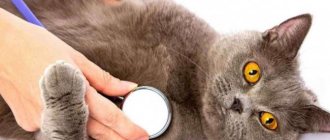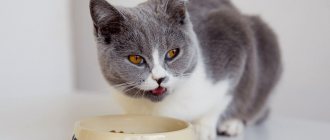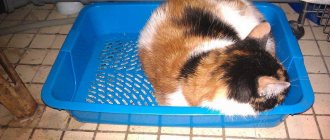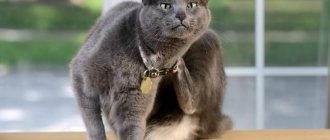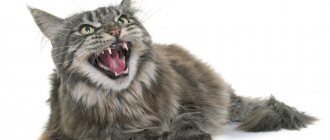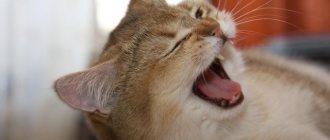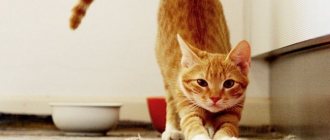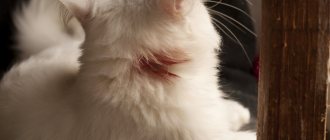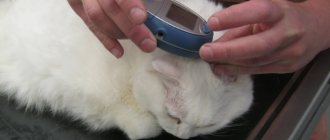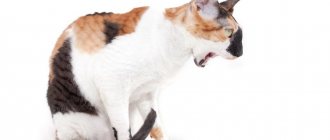It’s nice to communicate and play with cats: they are affectionate, fluffy, they like to bask in a person’s arms, purring... But sometimes our pets disturb us by making sounds that are not entirely “understandable”. Sometimes animals cough, sneeze, and sniffle. But all this is understandable. The cat could have caught a cold, or there might have been debris in his nose. But what if the cat grunts when breathing? Agree, it’s much more common to hear such sounds from a piglet, but not at all from your favorite furry “beast.”
Why this can happen: natural predisposition
If you are the owner of an “English” or a Persian cat, then you will most likely have to come to terms with his “oddities”. The fact is that animals of these breeds belong to the so-called brachycephalic varieties. This is the “scientific” name for mammals that have a shortened head with a characteristic “flat” muzzle.
In the process of breeding such animals, breeders encountered a lot of difficulties. So, the same Persians have a lot of genetic anomalies, many of which are tied to the genome, which provides these animals with a shortened full face of the skull. Whatever one may say, from a natural point of view such a structure is nonsense. In particular, all cats of these varieties are extremely unstable to the effects of very high and low temperatures: the air simply does not have time to warm up or, on the contrary, cool down in their nasal cavity.
In winter, Persians, Britons and cats similar to them constantly catch colds (they should not be allowed outside at all when the ambient temperature drops below 10° Celsius). In the summer, it’s hard and difficult for them to breathe in the heat - hence the “grunting”. Because of this, your pet regularly sneezes when he gets into a dusty room: his respiratory organs simply do not have time to filter everything. But there may be more to it than that.
The problem also lies in the structure of the soft tissues of their palate. Over time, especially in old pets, it can simply “sag,” thereby blocking the normal flow of air. Because of this, the animal becomes even more like a pig. In principle, there is no particular problem here, but... if the grunting becomes incessant, and your cat cannot sleep normally due to “heroic” snoring, we strongly advise you to take him to the veterinarian. It is quite possible that he will need surgery to correct the structure of the soft palate. During the intervention, the surgeon will cut off the “extra” parts that interfere with the normal passage of air. Another sign that “clearly hints” at the need for such a procedure is vomiting, which occurs with particularly strong “grunting”. But there are other causes of grunting breathing, many of which are not so “harmless”.
Cat sounds are more varied than they seem.
Everyone knows that cats purr and meow. We learn about this in early childhood. However, the auditory signals given by a cat are much more varied and complex. The cat growls, grunts, snorts, hisses, howls.
Even a simple meow takes different forms depending on the emotions that the animal is experiencing at the moment. However, you should not think that the sounds of cats are only a reflection of the mood of our pets. They perform another important function: they serve for communication. So if you know their meaning, talking to your cat will be much easier.
Photo: Pixabay
"Parasitic" problems
It is known that finding a cat that has not had helminths in its life is a task that is almost impossible in practice. It is extremely easy to “pick up” a parasite for a cat - he does not wash his paws with soap. On the contrary, our clean pets constantly lick their fur, to which anything can stick. For example, parasite eggs. Professional veterinarians generally recommend treating their pets with antiparasitic agents at least once a quarter, since otherwise problems cannot be avoided. Moreover, this must be done at intervals of two weeks...
Purr
After a busy day at work, you feel happier when your cat snuggles up to you, sniffs and purrs. Like oh, purring is like how blind and deaf kittens communicate with their mother, but all cats use this means of communication throughout their lives, even with you. Pay close attention to your cat's purrs and you'll notice subtle changes in tone and vibration, all of which indicate that your cat is happy and well.
A lesser-known meowing motif: cats can use these sounds to calm themselves when they're scared, so don't forget to show her some love when you hear her "little motor."
Inflammation of the trachea
It is also “tracheitis”. It occurs due to many reasons, with the leading one being the effect of too low temperatures. Your cat, just like a person, can get very cold in frosty or chilly weather. Hypothermia contributes to the deterioration of the animal’s body’s defenses, as a result of which the rapid growth and development of pathogenic and conditionally pathogenic microflora begins. The logical result is that the animal breathes poorly through its nose, making grunting, wheezing and wheezing sounds. But the main symptom of tracheitis is cough.
Pharyngeal (pharyngeal) reflex
This condition is also called “paroxysmal breathing” or “reverse sneezing.” It is not a disease, but it looks quite alarming and unusual.
Paroxysmal breathing is recorded not only in cats, but also in dogs and people.
According to felinologists, its cause is irritation of the soft palate, resulting in a kind of spasm. At the same time, the animal rests on its forelimbs, stretches its neck, arches its back and produces sounds reminiscent of a noisy short breath, sneezing, coughing and grunting at the same time.
Causes. The condition can be provoked by:
- emotional state and stress;
- quickly eating or drinking liquids;
- inhalation of cigarette smoke, dust, pollen and other allergens;
- pungent odors;
- respiratory infections;
- squeezing the throat with a harness.
Progression and diagnosis. Usually the cat copes with an attack of reverse sneezing on its own, however, if the respiratory abnormality becomes more and more obvious, then perhaps the animal really is sick. In particular, a gradual increase in symptoms is caused by neoplasms growing in one or another part of the respiratory tract. The owner will be able to independently diagnose them only if the tumors become too large and manifest themselves externally, or enter the decay phase and begin to bleed. Ultrasound diagnostics and x-rays will help dispel all doubts.
Foreign bodies
Just like a person, a cat may well choke while eating. Sometimes a couple of minutes are enough for him to cough properly, but sometimes an unsuccessfully swallowed piece of food can end up in the lumen of the respiratory tract. This is fraught not only with the development of “grunting” breathing, but also with something more serious, including the possibility of death from suffocation.
If your cat suddenly starts grunting, wheezing and coughing immediately after eating, call the vet immediately! Even in mild cases, when a foreign body only partially blocks the lumen, all visible mucous membranes of the pet quickly turn blue and become engorged with blood . The result is death from suffocation or severe pulmonary edema . Of course, you can try to remove the foreign body yourself, but in cases where you do not have the appropriate veterinary or medical experience, you should not do this. You will only aggravate the pathological process and possibly injure the animal.
Unfortunately, pieces of unsuccessfully swallowed food are not the worst thing. A similar clinical picture can be caused by tumors, not only benign, but also malignant . Grunting in such cases develops gradually. Neoplasms, as a rule, take a long time to grow, and therefore owners may not attach much importance to the pet’s strange behavior.
Thus, all the strange sounds that your cat begins to make are a reason for an immediate visit to the clinic. Perhaps in this way you will save his health and even his life.
Foreign object
When a cat coughs as if it was choking, instead of panicking, it is advised to determine the time and duration of the reflex and assess the pet’s condition. Sometimes an animal greedily gobbles up the food it likes, and food particles stick to the roof of the mouth. To get rid of the problem, the cat sticks out its tongue, coughs up small particles of food that come out along with the vomit, and stops stretching its neck.
The owner should be wary when the animal tries to open its mouth wide and rubs it with its paw, since the reason why the cat coughs, as if choking, is:
- blade of grass or sliver;
- filler or bead;
- a piece of rope;
- toy part;
- bone from fish, chicken.
An animal that makes hoarse sounds without belching should be picked up, and the mouth should be inspected by opening its mouth. If the cat owner cannot remove the object on his own, he should contact a veterinarian.
What does it mean if a cat meows in response?
Cats are sensitive to the tone, timbre, and volume of voices. Of course, they are not trying to talk to us in the generally accepted sense of the word. But, having meowed once to the owner in response to his speech addressed to the animal, having caught an approving reaction, the cat will practice this action again and again.
Interesting materials:
How much does Tele2 SMS cost in Russia? How much does Surrogacy cost in Russia 2022? How much does temporary registration in Russia cost? How much does a call from Russia to Armenia cost MTS? How much does a call from Russia to Uzbekistan cost? How many pages are there in the Constitution of the Russian Federation? How many Tatars are there in the Russian Federation? How many tons of gold are mined in Russia? How much is the working-age population in Russia? How many kings were there in Russia?
Video "Cat's reaction when she sees a bird outside the window"
Cat ringtones are quite varied. And although when cats meow the video is not always successful, in this video you will still hear the cat meowing and see how it behaves when it sees a bird outside the window without being able to catch it.
Was this article helpful?
Thank you for your opinion!
The article was useful. Please share the information with your friends.
Yes (50.00%)
No (50.00%)
X
Please write what is wrong and leave recommendations on the article
Cancel reply
Rate the benefit of the article: Rate the author ( 13 votes, average: 3.69 out of 5)
Discuss the article:
Viral respiratory diseases
Coughing, wheezing, grunting and bubbling breathing in cats can be caused by an infectious disease. The accumulation of exudate in the pharynx often leads to vomiting. Risk groups include:
- young animals up to 5 months;
- unvaccinated free-range animals in contact with possible carriers of the disease;
- weakened and exhausted individuals after injuries, operations and other diseases;
- older cats.
Symptoms. In addition to respiratory dysfunction, viral pathologies of the respiratory tract have other clinical symptoms:
- increase in body temperature to +40°C and above;
- complete refusal to eat;
- lethargy, weakness and depression;
- purulent conjunctivitis;
- serous-purulent rhinitis;
- manifestations of stomatitis with tongue ulceration and the flow of sticky saliva.
Complications. Lack of treatment at the first stage often leads to the death of kittens, and in adults the course of the disease becomes more complicated:
- pneumonia;
- ulcerative lesions of the skin and mucous membranes;
- deep ulcerative keratitis with loss of vision;
- trembling, loss of coordination and other nervous disorders.
Therapeutic measures. Treatment of respiratory tract pathologies is carried out by a veterinarian using:
- broad-spectrum antibiotics;
- antiviral drugs and immunostimulants;
- vitamin and mineral complexes;
- intravenous administration of glucose and saline solutions;
- antiseptic solutions for washing affected mucous membranes of the mouth;
- eye drops and ointments.
As preventive measures, it is recommended to carry out annual vaccinations, provide your pet with a balanced diet and properly care for it.
Helminthiasis
An animal carrying parasitic worms can make unusual grunting sounds.
Toxocara. The development cycle of the Toxocara nematode begins with the cat swallowing food infested with larvae or eating the intermediate host of the parasite, which is:
- mouse;
- rat;
- bird;
- insect.
Development in the body . In the intestine, the larva actively invades the blood vessel through the epithelial wall in order to enter the lungs with the bloodstream. Young parasites feed on the blood and tissues of the airways, causing severe irritation, difficult wheezing breathing and a reflex cough.
The damaging effect leads to the attachment of pathogenic bacteria that increase inflammation. With a cough, some of the larvae enter the oral cavity and are swallowed again, growing in the intestines into a mature worm. During the period of migration of larvae into the digestive tract, the cat may experience the urge to vomit.
Hookworm. Hookworm larvae cause hookworm disease by entering the cat’s body in several ways:
- simultaneously with food and water;
- when self-licking;
- through the skin with subsequent penetration into the bloodstream;
- when eating infected rodents.
Development. The path of larvae that have penetrated through the skin into the blood lies in the respiratory tract, and then, when coughing, into the oral cavity.
After 3 weeks, swallowed parasite embryos grow in the intestines into adult individuals that feed on the blood of the host animal.
Clinical picture of helminthic infestation. Infection with helminths in a cat is indicated by:
- poor appetite and weight loss;
- apathetic behavior;
- disruptions in the gastrointestinal tract;
- increase in abdominal volume;
- the appearance of mucus and blood in feces;
- unkempt appearance, poor coat;
- constant discharge from the eyes;
- pallor of the mucous membranes in the mouth.
Diagnosis and treatment. The diagnosis is based on laboratory tests of blood and feces. Having determined the type of helminth, anthelmintic drugs are prescribed in the required dose and, possibly, with repeated use.
Also watch the video of a cat breathing with wheezing:
Description of possible causes
If the cat grunts through its nose when breathing, but there is no snot or discharge from the eyes, then it is worth eliminating the option of a foreign body getting into the throat or nostrils, which brings discomfort to the pet.
If there is discharge from the nose, eyes, sneezing and coughing, then it is best not to hesitate to contact a veterinarian, especially in the case of kittens for whom viral diseases are life-threatening.
In adults and individuals and kittens, grunting can be caused by the following reasons.
Foreign body
If an animal gets something into its nasopharynx, it begins to behave restlessly, as it feels discomfort. This often manifests itself as head shaking, coughing, grunting, and rapid breathing.
In most cases, the foreign body is food debris (bones from fish or meat), which irritate the pet’s mucous membrane. Because of this, the cat may take breaths that sound a lot like grunting. Pieces of toys, broken twigs, plant seeds, or weed needles can also get stuck.
It is recommended to independently examine the nasopharynx (if possible) and remove the foreign body using tweezers. If nothing is visible or the splinter is in an inaccessible place, do not hesitate to visit the veterinarian.
Even after removing the irritant, the pet will sniffle and even grunt for some time. This is considered normal, since the mucous membrane is irritated and has not yet healed.
Calicivirus
A common respiratory viral infection that occurs in cats of all ages. At the initial stage it manifests itself in the form of fever, nasal discharge, cough.
As the process progresses, grunting through the nose and purulent discharge from the eyes are added. Also characteristic symptoms of calcivirosis are ulcers that affect the upper palate, tongue, gums, and the inside of the lips and cheeks. You can become infected through close contact with a sick animal (by licking or sniffing each other, scratching or biting).
Calicivirus very often “rages” in nurseries , so it is recommended to be very careful when choosing a kitten. There are many cases where unscrupulous breeders explained the symptoms of a viral infection with the usual characteristics of the breed (sour eyes, grunting nose).
Treatment in each case is individual, since antiviral drugs are prescribed based on the severity of the clinical picture. This could be Amoxicillin and Immunofan.
PCR diagnostics and its correlation with symptoms are of great importance, since it must be remembered that the animal can excrete the virus for up to 2 months after complete recovery. Some individuals remain virus carriers until the end of their lives.
Infectious rhinotracheitis
And although the mortality rate for this disease is small (no more than 8-10%), in kittens it is very painful. Adults are also susceptible to the virus, but their clinical picture is usually not aggravated by weakness, lethargy and impotence.
In general, rhinotracheitis occurs in a standard manner for viral infections – fever, sneezing, sour eyes. Subsequently, grunting through the nose is added due to the abundance of purulent discharge and a wet cough.
It should be remembered that rhinotracheitis is seasonal. For example, most cases are recorded in the spring and autumn. Treatment is strictly symptomatic - mucolytics and expectorants for severe coughs, rinsing the nose if there is snot, treating the eyes for conjunctivitis.
Neoplasms
They can also cause your cat to grunt when breathing. In young individuals, polyps most often occur that grow in the nasal passages. In pets over the age of 10 years, it is necessary to exclude the possibility of an oncological process.
This will require rhinoscopy, radiography, biopsy, histology and cytology. After determining the type of formation, effective treatment is selected (surgical removal, chemotherapy, radiation).
Breed Features
Owners of brachycephalic breeds should remember that in British, Scottish, Persian and exotic breeds, nose grunting can be caused by the anatomical structure of the muzzle. The narrowing of the nasal passages leads to the appearance of whistling, hissing and grunting sounds during breathing. Brachycephalics can also snore heavily, which may come as a surprise to owners who have never dealt with this breed before. Nothing can be done about this (except for surgery, of course).
This is interesting: Do cats swim?
